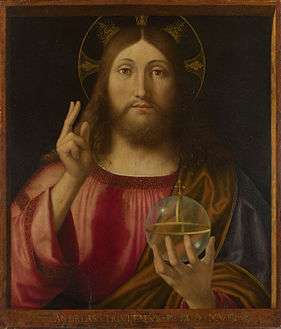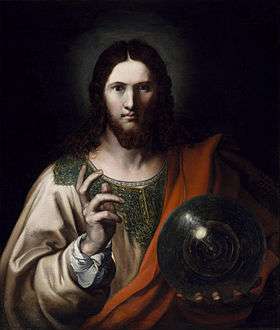Salvator Mundi
For the Leonardo painting, see Salvator Mundi (Leonardo da Vinci).
Salvator Mundi, Latin for Saviour of the World, is a subject in iconography depicting Christ with his right hand raised in blessing and his left hand holding an orb surmounted by a cross, known as a globus cruciger. The latter symbolizes the Earth, and the whole composition has strong eschatological undertones.
The theme was made popular by Northern painters such as Jan van Eyck, Hans Memling, and Albrecht Dürer. There are also several versions of the theme attributed to Titian, notably the one in the Hermitage Museum. A painting of the subject has been attributed to Leonardo da Vinci in 2011.
Gallery
_Salvator_Mundi_circa_1500.jpg) Leonardo da Vinci, Salvator Mundi (c. 1500)
Leonardo da Vinci, Salvator Mundi (c. 1500) Andrea Previtali, Salvator Mundi (1519)
Andrea Previtali, Salvator Mundi (1519) Titian's version of Salvator Mundi (1570)
Titian's version of Salvator Mundi (1570) Unknown artist, Salvator Mundi (third quarter of 16th century)
Unknown artist, Salvator Mundi (third quarter of 16th century)- Stained glass panel in the transept of St. John's Anglican Church, Ashfield, New South Wales
External links
 Media related to Salvator Mundi at Wikimedia Commons
Media related to Salvator Mundi at Wikimedia Commons- Details on de Ganay's Salvator Mundi
This article is issued from Wikipedia - version of the 10/31/2015. The text is available under the Creative Commons Attribution/Share Alike but additional terms may apply for the media files.